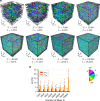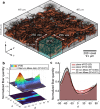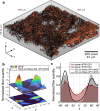Fourier transform-based method for quantifying the three-dimensional orientation distribution of fibrous units
- PMID: 38263352
- PMCID: PMC11222475
- DOI: 10.1038/s41598-024-51550-5
Fourier transform-based method for quantifying the three-dimensional orientation distribution of fibrous units
Abstract
Several materials and tissues are characterized by a microstructure composed of fibrous units embedded in a ground matrix. In this paper, a novel three-dimensional (3D) Fourier transform-based method for quantifying the distribution of fiber orientations is presented. The method allows for an accurate identification of individual fiber families, their in-plane and out-of-plane dispersion, and showed fast computation times. We validated the method using artificially generated 3D images, in terms of fiber dispersion by considering the error between the standard deviation of the reconstructed and the prescribed distributions of the artificial fibers. In addition, we considered the measured mean orientation angles of the fibers and validated the robustness using a measure of fiber density. Finally, the method is employed to reconstruct a full 3D view of the distribution of collagen fiber orientations based on in vitro second harmonic generation microscopy of collagen fibers in human and mouse skin. The dispersion parameters of the reconstructed fiber network can be used to inform mechanical models of soft fiber-reinforced materials and biological tissues that account for non-symmetrical fiber dispersion.
© 2024. The Author(s).
Conflict of interest statement
The authors declare no competing interests.
Figures










References
-
- Brenken B, Barocio E, Favaloro A, Kunc V, Pipes RB. Fused filament fabrication of fiber-reinforced polymers: A review. Addit. Manuf. 2018;21:1–16. doi: 10.1016/j.addma.2018.01.002. - DOI
-
- Bosnjak N, Wang S, Han D, Lee H, Chester SA. Modeling of fiber-reinforced polymeric gels. Mech. Res. Commun. 2019;96:7–18. doi: 10.1016/j.mechrescom.2019.02.002. - DOI
-
- Chen Z, et al. An anisotropic constitutive model for 3D printed hydrogel-fiber composites. J. Mech. Phys. Solids. 2021;156:104611. doi: 10.1016/J.JMPS.2021.104611. - DOI
Grants and funding
LinkOut - more resources
Full Text Sources

